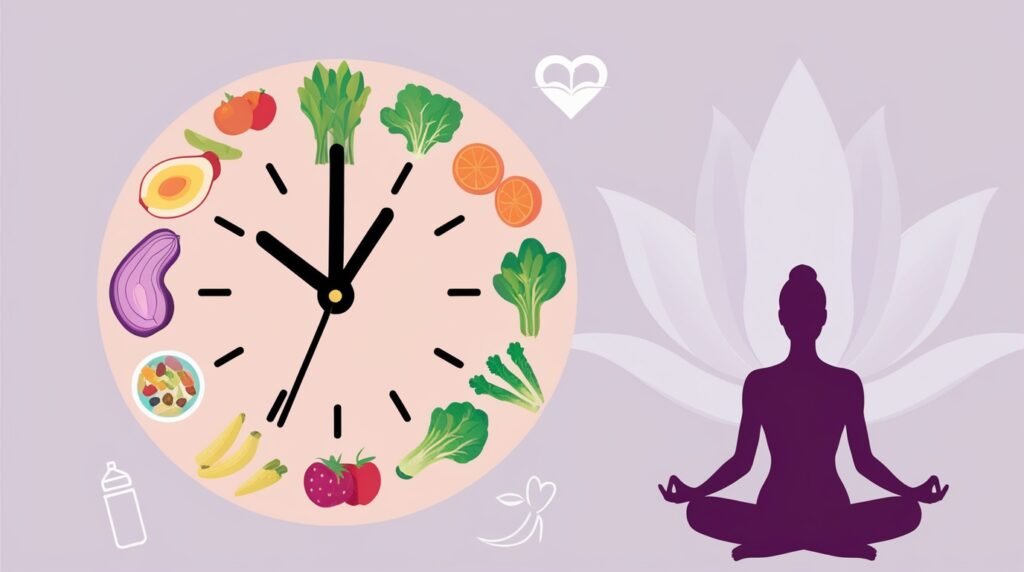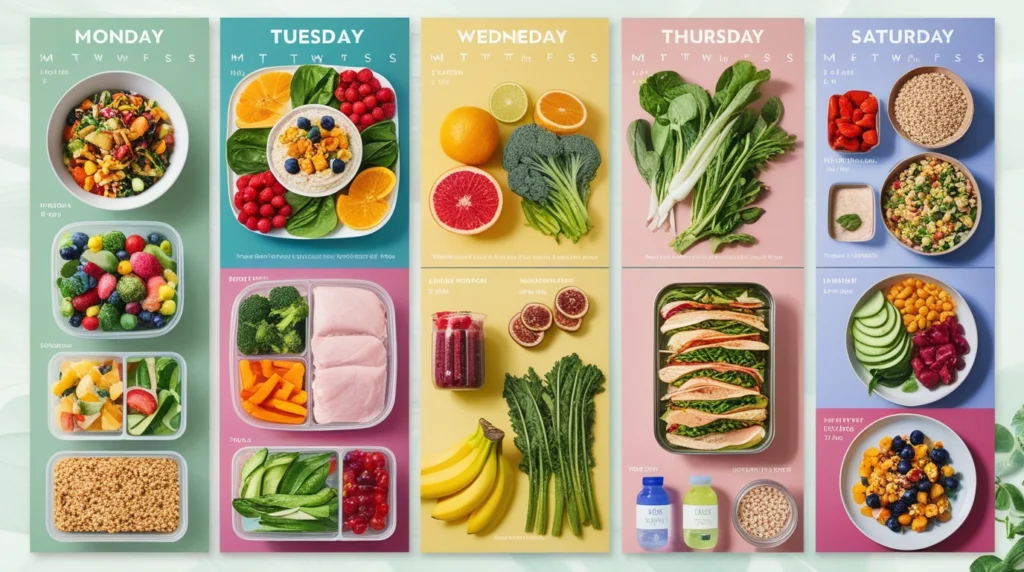Did you know 72% of women worldwide have tried intermittent fasting? Yet, many find it hard to find a schedule that fits their body and life. This guide will help you find the perfect intermittent fasting schedule for women to reach your health goals.

Key Takeaways
- Discover personalized intermittent fasting schedules tailored for women’s health and hormonal needs
- Understand the science behind why women respond differently to fasting compared to men
- Learn how to adapt your fasting window to accommodate your menstrual cycle
- Explore effective strategies to manage hunger, cravings, and sustain your fasting routine
- Gain insights on safety considerations and when to modify or stop your intermittent fasting plan
Understanding Intermittent Fasting Basics for Women
Intermittent fasting is popular for weight loss, but it affects women differently. Hormonal changes and unique needs can impact how it works for them.
How Female Hormones Impact Fasting
Estrogen and progesterone control metabolism, hunger, and energy in women. These hormones change with the menstrual cycle. This affects how women respond to intermittent fasting protocols for females.
Key Benefits for Women’s Health
- Improved insulin sensitivity and reduced risk of type 2 diabetes
- Enhanced weight management and fat loss
- Reduced inflammation and improved cardiovascular health
- Increased mental clarity and cognitive function
Gender-Specific Considerations
When fasting for weight loss, women need to consider their menstrual cycle and reproductive health. Adjusting fasting times can help maximize benefits and reduce risks.
“Intermittent fasting can be a powerful tool for women, but it’s crucial to approach it with an understanding of how it may interact with their hormonal landscape.”
Women can tailor intermittent fasting to fit their health needs. This way, they can enjoy its benefits while staying healthy.
The Science Behind Women’s Intermittent Fasting
Intermittent fasting has become popular for its health benefits. Studies show it works well for women too. They found out how women’s bodies react to fasting.
Research looks at how fasting affects female hormones. It shows fasting can balance hormones like estrogen and cortisol. This can help with menstrual cycles, PCOS, and fertility.
Intermittent fasting also boosts metabolism in women. It makes insulin work better, lowers inflammation, and helps lose fat. These benefits are good for weight, diabetes risk, and heart health.
Timing of fasting is key for women’s health. Some studies suggest a women’s intermittent fasting plan with a 14/10 window might be better than 16/8 for some.
In summary, the science on intermittent fasting schedule for women is strong and growing. Understanding women’s bodies helps tailor fasting plans. This supports their health and well-being.
Popular Intermittent Fasting Schedule for Women
Intermittent fasting is popular among women looking to improve their health. There are many fasting plans, but three stand out: the 16/8, 14/10, and 5:2 methods. Let’s explore each to find the best fit for you.
The 16/8 Method
The 16/8 method, or Leangains protocol, means fasting for 16 hours and eating in an 8-hour window. It boosts insulin sensitivity and fat burning. It’s great for beginners because it fits easily into daily life.
The 14/10 Method for Beginners
The 14/10 method is perfect for newbies. It involves fasting for 14 hours and eating for 10 hours. It’s less strict than 16/8 and helps you ease into fasting.
The 5:2 Protocol Explained
The 5:2 protocol lets you eat normally for 5 days and limits calories on 2 days. On fasting days, you eat 500-600 calories. It’s flexible and good for busy women.
Choosing an intermittent fasting plan depends on your lifestyle and health. Try different methods to see what works best for you.
Choosing the Right Fasting Window for Your Lifestyle
When it comes to intermittent fasting for women, picking the right fasting window is crucial. It’s about finding a schedule that fits your daily life and preferences. This makes it easier to stick with it over time.
The 16/8 method is a popular choice. It means fasting for 16 hours and eating for 8. It’s flexible and works well for many women. But, if you’re new, the 14/10 method might be easier. It has a 14-hour fast and a 10-hour eating window.
The 5:2 method is great for those who like a structured plan. You fast for two days a week and eat normally the other five. It helps women focus on mindful eating.
- Think about your work, social life, and what you like when picking a fasting window.
- Start with something like the 14/10 method and adjust as you get used to it.
- Be open to trying different schedules to find the best intermittent fasting timing for women for you.
The best intermittent fasting schedule for women is one you can stick to. It should not hurt your health or happiness. By finding the right schedule, you’ll enjoy the many benefits of fasting.
Common Mistakes Women Make When Starting Intermittent Fasting
Starting intermittent fasting can help women lose weight. But, many women face common challenges at first. Knowing these mistakes can help you avoid them and get better results.
Fasting Window Errors
Choosing the wrong fasting window is a common mistake. Intermittent fasting protocols for females suggest a 16-hour fast or less. But, some women try to fast too long, making it hard to keep up.
It’s important to pick a fasting window that fits your life and preferences. This is key to success with intermittent fasting for weight loss in women.
Hydration Oversights
- Drinking enough water during fasting is crucial, but many women forget.
- Not drinking enough water can cause headaches, fatigue, and other issues. These can make fasting hard.
- Drink water regularly and consider adding electrolyte-rich drinks to your routine.
Exercise Timing Mistakes
Timing exercise during fasting is another challenge. Doing intense workouts while fasting can make you tired and burn out. Instead, do lighter activities like walking or yoga during fasting.
By avoiding these common mistakes, women can succeed with intermittent fasting protocols for females. They can reach their weight loss and health goals.
Creating a Sustainable Meal Plan During Eating Windows
When you follow an intermittent fasting plan, making a balanced meal plan is key. It keeps you healthy and gives you energy and satisfaction. Focus on whole foods that are full of nutrients.
To make a good intermittent fasting meal plan for females or a women’s intermittent fasting plan, follow these tips:
- Prioritize lean proteins like chicken, fish, tofu, or legumes to support muscle maintenance and repair.
- Include a variety of fiber-rich vegetables and fruits to aid digestion and provide essential nutrients.
- Choose complex carbohydrates like whole grains, quinoa, or sweet potatoes to deliver long-lasting energy.
- Incorporate healthy fats from nuts, seeds, avocado, or olive oil to promote satiety and hormone balance.
- Hydrate well by drinking plenty of water, herbal teas, or low-calorie beverages during your eating windows.
The goal is to make a women’s intermittent fasting plan that nourishes your body. Try different meals and sizes to find what’s best for you.
“Eating well-balanced meals during your eating windows is key to making intermittent fasting a long-term lifestyle change.”

By following these tips, you can create a intermittent fasting meal plan for females. It will give you the nutrients, energy, and satisfaction you need.
Adapting Fasting Schedules to Your Menstrual Cycle
Women’s menstrual cycles are key to our health. Understanding how our hormones affect fasting is crucial. This is true for intermittent fasting schedule for women and intermittent fasting timing for women.
Follicular Phase Adjustments
The follicular phase starts with your period and ends at ovulation. Your estrogen levels go up, boosting your energy and focus. This is a great time to try longer fasts.
You might find a 16/8 or 18/6 intermittent fasting schedule for women fits well here.
Luteal Phase Modifications
The luteal phase follows ovulation until your next period. Estrogen drops, and progesterone rises, making you hungrier and more tired. It’s time to adjust your intermittent fasting timing for women.
Try a 14/10 or 12/12 intermittent fasting schedule for women during this phase. It helps meet your changing needs.
Every woman is different. Listen to your body and find the intermittent fasting schedule for women that suits you best. Adjusting your fasting to match your cycle can improve your health and well-being.
Exercise and Physical Activity During Fasting Periods
Adding exercise to your intermittent fasting protocols for females can greatly improve your health and help with weight loss. Timing your workouts during fasting can enhance these benefits even more.
Choose low-to-moderate intensity exercises like walking, yoga, or light strength training during fasting. These activities don’t drain your energy too much. High-intensity workouts, like HIIT, are better for when you’re eating, when you have more energy.
It’s important to stay hydrated and keep your electrolytes balanced while fasting and exercising. Drink lots of water and consider adding electrolytes like sodium, potassium, and magnesium to meet your body’s needs.
Timing Your Workouts for Maximum Benefit
- Try to exercise later in your fasting window, when your body is burning fat more efficiently.
- Have a nutrient-rich meal or snack right after working out to refill your energy and help muscles recover.
- Play around with different workout times to see what works best for you.
By adding exercise to your intermittent fasting protocols for females, you can get the best of both worlds. A bit of trial and error will help you find the perfect balance for your health and intermittent fasting for weight loss in women.
Managing Hunger and Cravings While Fasting
Keeping up with an intermittent fasting schedule can be tough, mainly because of hunger and cravings. But, with smart strategies, women can beat these challenges. This way, they can stick to their best intermittent fasting schedule for women.
Natural Appetite Suppressants
One good way is to add natural appetite suppressants to your meals. These include:
- Fiber-rich foods like chia seeds, flaxseeds, and oats, which help you feel full
- Protein-rich snacks such as Greek yogurt, nuts, and hard-boiled eggs, which can reduce hunger
- Caffeine from green tea or black coffee, which can temporarily block hunger
Mindful Eating Strategies
Practicing mindful eating is also key to handling hunger and cravings during intermittent fasting schedule examples for women. This means:
- Drinking lots of water all day to stay hydrated
- Using relaxation techniques like deep breathing or meditation to ignore cravings
- Avoiding triggers like walking by your favorite snack foods or browsing social media during meals
- Enjoying the taste, texture, and smell of your food during your eating times
By using these strategies, women can overcome the hurdles of intermittent fasting. They can keep their health and wellness goals in sight.

Tracking Progress and Adjusting Your Fasting Schedule
Starting your intermittent fasting for weight loss in women journey? It’s key to track your progress and adjust your women’s intermittent fasting plan as you go. Watching how your body reacts to fasting helps you refine your method. This ensures you meet your health and wellness targets.
Measuring Your Progress
First, focus on these key areas:
- Weight changes
- Body composition (muscle mass, body fat percentage)
- Energy levels and overall well-being
- Hunger and cravings during fasting periods
- Menstrual cycle and hormonal changes (if applicable)
Keep track of your weight, body measurements, and how you feel. This info shows how your body is adjusting to fasting.
Adjusting Your Fasting Schedule
Use the data you gather to tweak your fasting schedule. You might change the length of your fasting times, how often you fast, or when you eat. Try different approaches to find the best intermittent fasting for weight loss in women plan for you.
“Tracking your progress and being open to adjustments is key to long-term success with intermittent fasting.”
Remember, there’s no single way to do women’s intermittent fasting plan. Be patient and listen to your body. Make small changes to find a balance that helps you reach your goals without sacrificing your health.
Safety Considerations and When to Stop Fasting
When it comes to intermittent fasting protocols for females and intermittent fasting schedule for women, safety is key. This diet can be beneficial, but it’s important to watch for warning signs. Also, some medical conditions may need extra care or a break from fasting.
Warning Signs to Watch For
It’s vital to listen to your body while fasting. Look out for any symptoms that seem off. Some signs you might need to adjust or stop fasting include:
- Persistent fatigue or dizziness
- Frequent headaches or migraines
- Irregular or absent menstrual cycles
- Difficulty concentrating or brain fog
- Irritability, mood swings, or heightened anxiety
- Frequent digestive issues, such as constipation or bloating
Medical Conditions That Require Caution
Some health issues might need you to be more careful or talk to a doctor before starting intermittent fasting. These include:
- Diabetes or other blood sugar-related disorders
- History of eating disorders or disordered eating
- Thyroid dysfunction
- Adrenal fatigue or hormonal imbalances
- Pregnancy or breastfeeding
Remember, everyone reacts differently to intermittent fasting. It’s important to pay attention to how your body feels. If you notice any concerning symptoms or have health concerns, talk to a doctor before changing your diet.
Supporting Your Body During Fasting Windows
Starting an intermittent fasting meal plan for females or intermittent fasting timing for women needs careful body attention. It’s key to keep your health up during fasting times. This ensures a good and lasting fasting journey.
Staying Hydrated
Drinking enough water is crucial when fasting. Drink lots of water all day, even when fasting. It keeps your body fluids balanced, helps organs work right, and can make hunger feel less.
Balancing Electrolytes
Electrolytes like sodium, potassium, and magnesium are very important. Make sure to replace these minerals, more so if you’re active while fasting.
Supplementing Wisely
- Think about adding supplements like multivitamins, omega-3s, and probiotics to help with fasting health.
- Talk to a doctor to find the right supplements for you.
Practicing Self-Care
Fasting can be tough on your body and mind. So, take care of yourself. Do things that relax you, sleep well, and listen to your body for a good fasting experience.
| Nutrient | Importance During Fasting | Food Sources |
|---|---|---|
| Water | Maintains hydration, supports organ function, and curbs hunger | Water, herbal tea, broth |
| Electrolytes (sodium, potassium, magnesium) | Regulates fluid balance and supports muscle and nerve function | Leafy greens, avocados, nuts, seeds, and sea salt |
| Multivitamins | Provides a comprehensive range of essential vitamins and minerals | Varies by supplement |
Focus on staying hydrated, balancing electrolytes, and taking care of yourself. This helps your body during intermittent fasting meal plan for females and intermittent fasting timing for women. Always check with a doctor to make sure your fasting plan fits your needs and goals.
Conclusion
As you’ve learned, the best intermittent fasting schedule for women fits your needs and lifestyle. You can pick from intermittent fasting schedule examples for women that match your goals. This is based on your unique hormonal profile and needs.
Choosing the 16/8 method, 14/10 for beginners, or 5:2 is just the start. The important thing is to be flexible and adjust as you go. Listen to your body and adjust your fasting times to fit your menstrual cycle. This way, you can make a fasting plan that works for you.
Health is a personal journey, not a one-size-fits-all deal. Stay committed, be patient, and celebrate your small wins. With the right mindset and this guide’s insights, you’re ready to see the benefits of intermittent fasting for women.
FAQ
What is the best intermittent fasting schedule for women?
The best schedule for women varies based on personal preferences and health goals. Options include the 16/8 method, the 14/10 method for beginners, and the 5:2 protocol. Choose a schedule that fits your daily life and can be kept up long-term.
How does intermittent fasting affect women’s hormones?
It can positively impact hormones, improving insulin sensitivity and menstrual cycles. It may also reduce PCOS risk. Women should adjust their fasting to match their hormonal changes.
What are the key benefits of intermittent fasting for women’s health?
Benefits include weight loss, better metabolic function, and reduced inflammation. It also improves heart health and can manage type 2 diabetes and PCOS.
How should women adjust their fasting schedule during their menstrual cycle?
Adjust fasting to match menstrual cycle phases. The follicular phase might be easier, while the luteal phase may need more adjustments for energy and hormones.
What are some common mistakes women make when starting intermittent fasting?
Mistakes include picking the wrong fasting window, not drinking enough water, and not matching exercise with fasting. Start slow, try different schedules, and listen to your body.
How can women create a sustainable meal plan during their eating windows?
Focus on balanced, nutrient-rich foods for energy and health. Include lean proteins, healthy fats, complex carbs, and fruits and vegetables.
How can women incorporate exercise and physical activity during their fasting periods?
Choose light to moderate exercise like walking, yoga, or gentle strength training during fasting. Consider workout intensity and timing.
What are some effective strategies for managing hunger and cravings while intermittent fasting?
Use natural appetite suppressants, practice mindful eating, and stay hydrated. Light physical activity and healthy distractions can also help manage cravings.
When should women consider stopping their intermittent fasting routine?
Stop if you experience chronic fatigue, severe headaches, or menstrual cycle disruptions. Always consult a healthcare professional, even for minor concerns.
References:
NIH – Effects of Intermittent Fasting on Hormones and Metabolism




